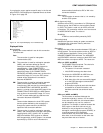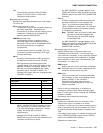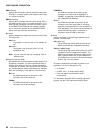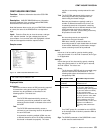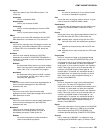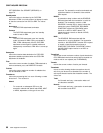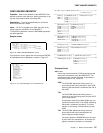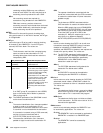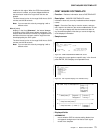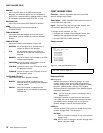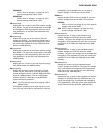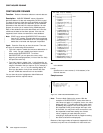
CEMT INQUIRE DB2ENTRY
CEMT INQUIRE DB2ENTRY
Function: Returns the attributes of the DB2ENTRY that
defines resources to be used by a specific transaction or by
a group of transactions when accessing DB2.
Description: The entry is identified by the name with
which it was defined in CEDA.
Input: For RCTs migrated to the CSD, the name is the
name of the first transaction on the DSNCRCT
TYPE=ENTRY statement unless the RDONAME parameter
has been specified.
Sample screen
inquire db2entry
STATUS: RESULTS - OVERTYPE TO MODIFY
Db2e(DB2ENT1 ) Use Ena Poo Hig Pro( ) Pth()
Threadl( ) Threads() Tpo Plane( DSNCUEXT
Db2e(DB2ENT2 ) Use Ena Poo Hig Pro( ) Pth()
Threadl( ) Threads() Tpo Plane( DSNCUEXT
Figure 56. CEMT INQUIRE DB2ENTRY screen
If you place the cursor against the result and press ENTER,
an expanded format is displayed as shown in Figure 57.
inquire db2entry
RESULT - OVERTYPE TO MODIFY
Db2entry(DB2ENT1)
Accountrec( None )
Authtype( Userid )
Enablestatus( Enabled )
Disabledact( Pool )
Priority( High )
Protectnum( )
Pthreads()
Threadlimit( )
Threads()
Threadwait( Tpool )
Plan( )
Planexitname( DSNCUEXT )
Authid( )
Drollback(Rollback)
Figure 57. The expanded display of an individual entry
─ ──CEMT Inquire DB2Entry(data-area)──┬ ┬─────────────── ─────
└┘──AT(data-area)
─ ──┬ ┬─────── ──┬ ┬────────────────── ──┬ ┬─────────────────── ───
├┤─START─ ├ ┤──ACCOUNTREC(cvda)└ ┘──AUTHID(data-area)
├ ┤─END─── ├ ┤─UOW──────────────
└ ┘─NEXT── ├ ┤─TASK─────────────
├ ┤─TXID─────────────
└ ┘─NONE─────────────
─ ──┬ ┬──────────────── ──┬ ┬─────────────────── ────────────────
├┤──AUTHTYPE(cvda)├ ┤──DISABLEDACT(cvda)
├ ┤─GROUP────────── ├ ┤─ABEND─────────────
├ ┤─SIGN─────────── ├ ┤─SQLCODE───────────
├ ┤─TERM─────────── └ ┘─POOL──────────────
├ ┤─TX─────────────
├ ┤─OPID───────────
└ ┘─USERID─────────
─ ──┬ ┬───────────────── ──┬ ┬──────────────────── ──────────────
├┤──DROLLBACK(cvda)├ ┤──ENABLESTATUS(cvda)
├ ┤─ROLLBACK──────── ├ ┤─ENABLED────────────
└ ┘─NOROLLBACK────── ├ ┤─DISABLED───────────
└┘─DISABLING──────────
─ ──┬ ┬───────────────── ──┬ ┬───────────────────────── ─────────
└┘──PLAN(data-area)└ ┘──PLANEXITNAME(data-area)
─ ──┬ ┬──────────────── ──┬ ┬─────────────────────── ────────────
├┤──PRIORITY(cvda)└ ┘──PROTECTNUM(data-area)
├ ┤─HIGH───────────
├ ┤─EQUAL──────────
└ ┘─LOW────────────
─ ──┬ ┬───────────────────── ──┬ ┬──────────────────────── ──────
└┘──PTHREADS(data-area)└ ┘──THREADLIMIT(data-area)
─ ──┬ ┬──────────────────── ──┬ ┬────────────────── ────────────
└┘──THREADS(data-area)├ ┤──THREADWAIT(cvda)
├┤─TWAIT────────────
├┤─NOTWAIT──────────
└┘─TPOOL────────────
Displayed fields
ACcountrec
returns the minimum amount of DB2 accounting record
required for transactions using this DB2ENTRY. The
specified minimum may be exceeded, as described in
the following options. The values are:
UOW
The CICS DB2 attachment facility causes an
accounting record to be produced for each UOW,
assuming that the thread is released at the end of
the UOW.
TAsk
The CICS DB2 attachment facility causes a
minimum of one accounting record for each CICS
task to be produced.
A transaction containing multiple UOWs may use
a different thread for each of its UOWs (assuming
the thread is released at syncpoint). The result
may be an accounting record produced for each
UOW.
TXid The CICS DB2 attachment facility causes an
accounting record to be produced when the
transid using the thread changes.
This option applies to DB2ENTRYs that are used
by more than one transaction ID. As threads are
typically released at syncpoint, a transaction
Chapter 11. Master terminal CEMT 67



